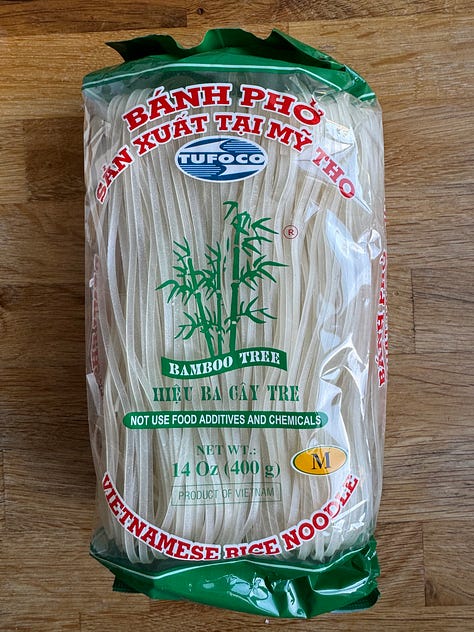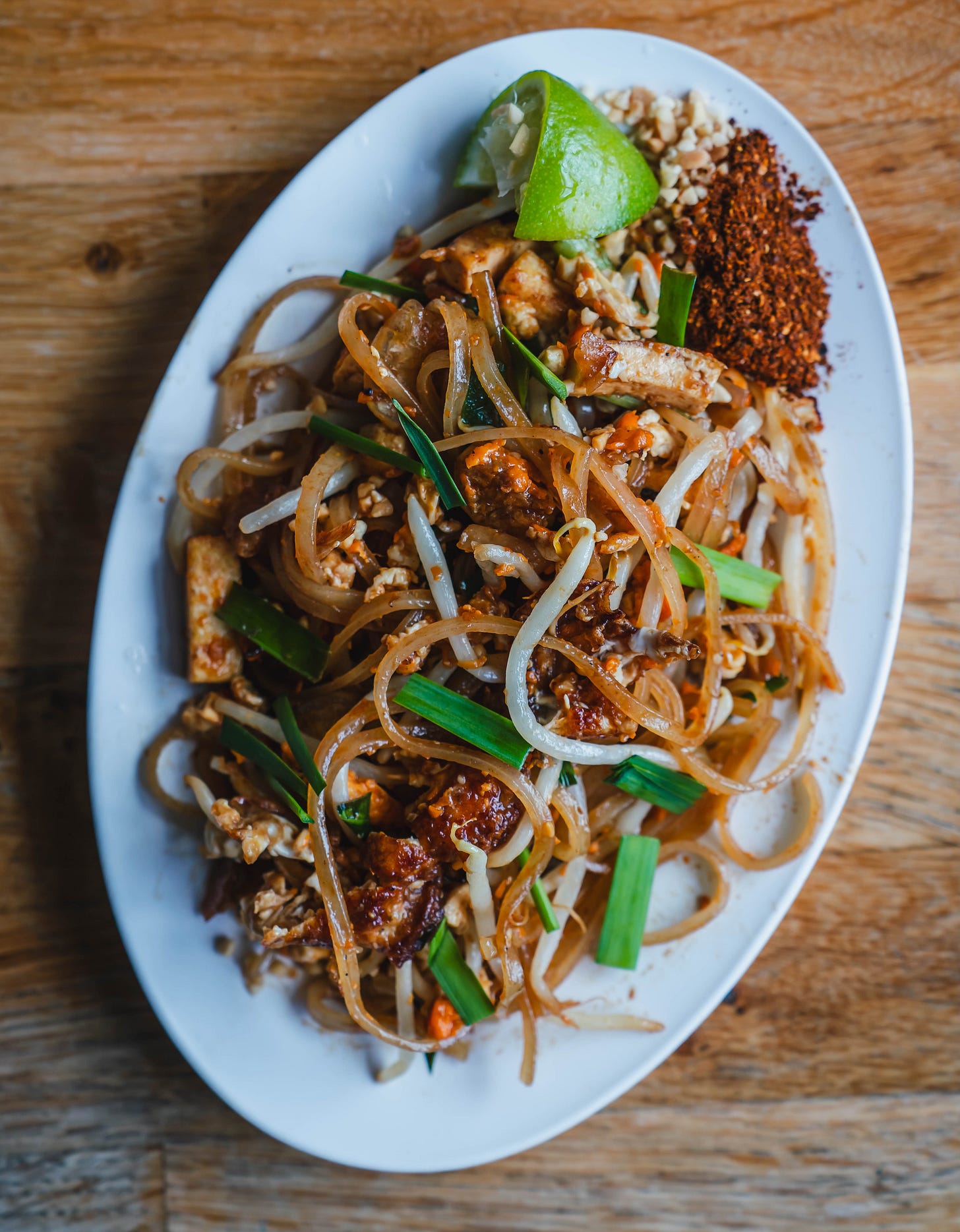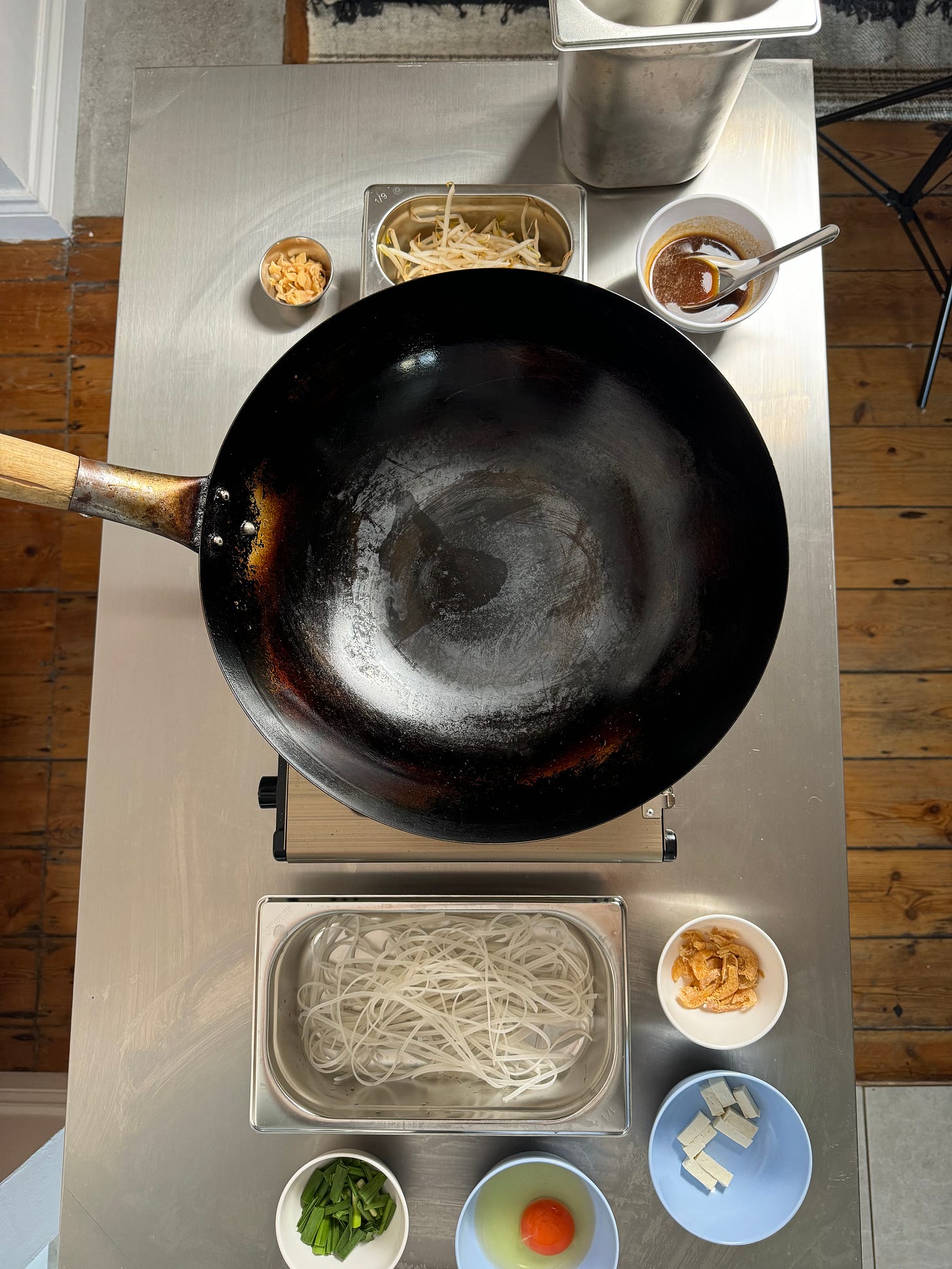Pad Thai, like fried rice, is much more difficult to cook than it appears. A lot of the recipes out there, I have found, are flat-out bad. Another issue is that Pad Thai is one of those dishes that requires a little cooking experience; intuition if you like - both of which are hard things to glean out of a book or a recipe. For example, one of the tricky things about cooking Pad Thai (at least for me) is cooking the noodles correctly. Because the noodles are cooked in a sauce, you must first soak them to a level of pliability that will allow them to be finished in the sauce. Some recipes suggest you steep noodles in boiling water for five minutes, others advise soaking the noodles in lukewarm water for half an hour, and some tell you to boil the hell out of the noodles (which is always a bad idea).
Compounding the issue is that each recipe will have a different type of noodle. Some will use thick noodles, others thin; some might even call for forms of vermicelli. And, of course, the size and shape of your noodles affect how much they will be cooked if they are steeped, soaked or boiled. So, whilst plonking wider rice noodles in boiling water for 5 minutes might work, doing the same with thinner noodles might cause them to turn into a soggy mess during the cooking process.
My point here is that it can be hard to distill the right approach into a simple instruction. I think the correct instruction is to soak your noodles to the point at which you are satisfied, and it is up to you as the cook to determine this. The only real way to do this is to practice this dish until you develop an intuition for it. But you have to start somewhere, I guess, and hopefully, this article, a reflection of my many trials and tribulations with this dish, serves as an honest starting point.
The Dish
As is customary, before I get into the workings of this dish, it's first important to take a look at its cultural context and history. Pad Thai is said to have been created (or, at the very least, promoted) by Thai Prime Minister Plaek Phibunsongkhram in the 1930s. Its promotion was partly a response to national rice shortages and partly an effort to spur nationalism and unification of the country. It certainly worked, and to this day, the dish is renowned the world over as an enduring emblem of Thai cuisine.
Core Features
The key constituent parts of Pad Thai are rice noodles, egg, garlic chives, beansprouts, dried shrimp, tofu, and a sauce mix containing fish sauce, palm sugar, and tamarind. Shrimp is a common protein, as is chicken and pork. It is customary to serve the dish with condiments that the eater can use to self-season, such as lime wedges, additional roasted peanuts, roasted chilli powder, fish sauce, and granulated sugar.



Problems & Solutions
Below are some problems and solutions I’ve realised when making this dish over the years.
Soggy noodles
As I waxed lyrical about before if you pre-cook your noodles too much, they'll overcook in your sauce mix, and you'll either end up with soggy, unappealing noodles or worse - they'll disintegrate in the pan. The most straightforward remedy to this is practice. Cook this dish a few times, and you'll get a feel for (a) how pliable your noodles should be before you add them to the wok and (b) how long they need to cook in the wok to be done. As a general guide, though, if you use the typical pad thai noodles (dried rice noodles of 3mm-5mm in width), soaking them in lukewarm water for 20 minutes is a good starting point.
Serving size & sauce-to-noodle ratio
I've found that a lot of published recipes completely over-index on the quantity of noodles called for. As just one example, one recipe I've used in the past (from a reputable chef) calls for 125 grams of dried noodles to go with just a few mere tablespoons of sauce mix (for a 1x serving size). Not only is this way too many noodles for the average person to eat in one sitting, but it also results in a dish where the noodles aren't adequately seasoned and where the pan doesn't get hot enough to char the noodles or caramelise the sauce mix (and I say this using a high-powered Iwatani portable burner that outputs 15,000BTUs or around double the amount of a standard home gas stove). I've found that 45 grams of dried noodles with a sauce mix that equates to around 4 tablespoons of liquid results in the perfect serving size for one person1 and results in a dish where the noodles are fully enveloped and seasoned by the sauce.

Portion control in the wok/pan
This is closely linked to the above point. I see a lot of recipes advising one to throw in 3-4+ portions into the one pan. For the same reasons espoused in this post, this is generally a bad idea and will result in a more steamed dish than fried. I have a 14-inch wok, which is a common size available to home cooks. As a rule of thumb, if I am cooking for 2 people, I'll get everything set up - i.e. 2X quantity of noodles, 2X sauce mix, etc. etc. and cook one portion at a time - eyeballing how much noodles/sauce/beansprouts to throw in for each portion.
Because this dish takes 4-5 mins to cook, it really doesn't extend the cooking process too much. If I'm cooking for 4X people, I'll do two portions at a time, which takes a little more concentration to get right but is still very doable. I'll never try to cook more than two portions in one pan. I think if you do, you lose the subtle extravagances of this dish, like the slight caramelisation of the sugar in the sauce mix and the wok hei that you can impart (providing you have a decently used and seasoned wok).
A recipe
The below recipe is one I've arrived at, and there are a few things to call out. I don't use a main protein because I like the dish just as much with simply egg and dried prawns. Though prawns, chicken or pork would make great additions. I also use gung siep dried prawns, a dried shrimp product from Phuket, which is exceptionally tasty. I don't think you can get them here, so normal dried prawns would work in a pinch. Finally, whilst I use regular firm tofu - the fancy pressed, marinated tofus marketed at veggies and vegans (like this one) would be excellent in this dish.
45g dried flat rice noodles, 3mm-5mm width
1/2 tbsp dried prawns
Around 2 tbsp firm tofu, cut into approx 4cm x 2cm rectangles (about 1cm thick)
1 tbsp chopped preserved radish (sometimes called preserved turnip)
1 egg
1/2 cup bean sprouts
3 tbsp garlic chives, cut into 3cm lengths
1 tbsp chopped roasted peanuts
2 tbsp tamarind water2
1.25 tbsp fish sauce
1 tbsp palm sugar
0.5 tsp dark soy sauce
2 tbsp of lard or vegetable oil
A cup of water on hand
Cover noodles in lukewarm water for 20 minutes, then set aside. They should be pliable but still a little stiff.
Make a sauce mix by mixing tamarind water, fish sauce, palm sugar and dark soy until the sugar is fully dissolved.
Heat a wok on high heat. Add lard or vegetable oil. Add the egg to the oil, then add the radish, dried prawns, and tofu on the outer sides of the egg (for a visual, see the full video of the process above).
As the egg cooks, mix the radish, dried prawns, and tofu around the oil, allowing them to cook in the fat. When the egg is 80% cooked, flip it, then scramble it into large, rough pieces. Quickly add the noodles, sprouts, chives, sauce mix and peanuts and begin to stir everything together vigorously.
The noodles should cook in the sauce as you stir. If you have a gas hob, you can adjust the heat accordingly. If it seems too hot and the sauce mix evaporates too quickly, turn the heat down slightly. But try to maintain a high heat, which will eventually caramelise the sugar in the sauce mix whilst also slightly charring the noodles. If you have an electric or induction hob, reduce the heat by taking the pan off the stovetop and mixing things off the heat.
In any instance, if the sauce mix evaporates too quickly and you feel the noodles haven't cooked through, add some water to the pan, which will help to moisten the noodles. Finish up when the noodles are cooked through and coated evenly in a sauce mix that has mostly evaporated but remains a sticky, tart envelope that covers the whole dish.
Enjoy.
Definitely on the smaller size and more akin to what you would get in Thailand compared to here but this is much better in my opinion than a huge slab of noodles
You can make this by mixing 1 part tamarind pulp, to 3 parts warm water then mixing it all together with your fingers and then straining it through a sieve. The Instagram video in this post shows the process briefly. Equally, you can buy pre-made liquid from stores which also work well.








I’ve probably made every mistake possible before now! I was getting close to your ‘perfect balance’ until now, so this guidance was given with care and enough detail to be fully usable and finish the job for me. The idea of ‘max two portions at a time’ carries across so many other dishes, and mimics what is happening both in the restaurant AND the street. It all happens fast and definitely improves the wok hei, other things being equal. Thanks for a great job!
Great read and thank you for clarifying a few things. Noodle dishes are tricky it’s all about the balance. I always soak the noodles, it’s dependent on what type of noodles I use as to how long I soak it.